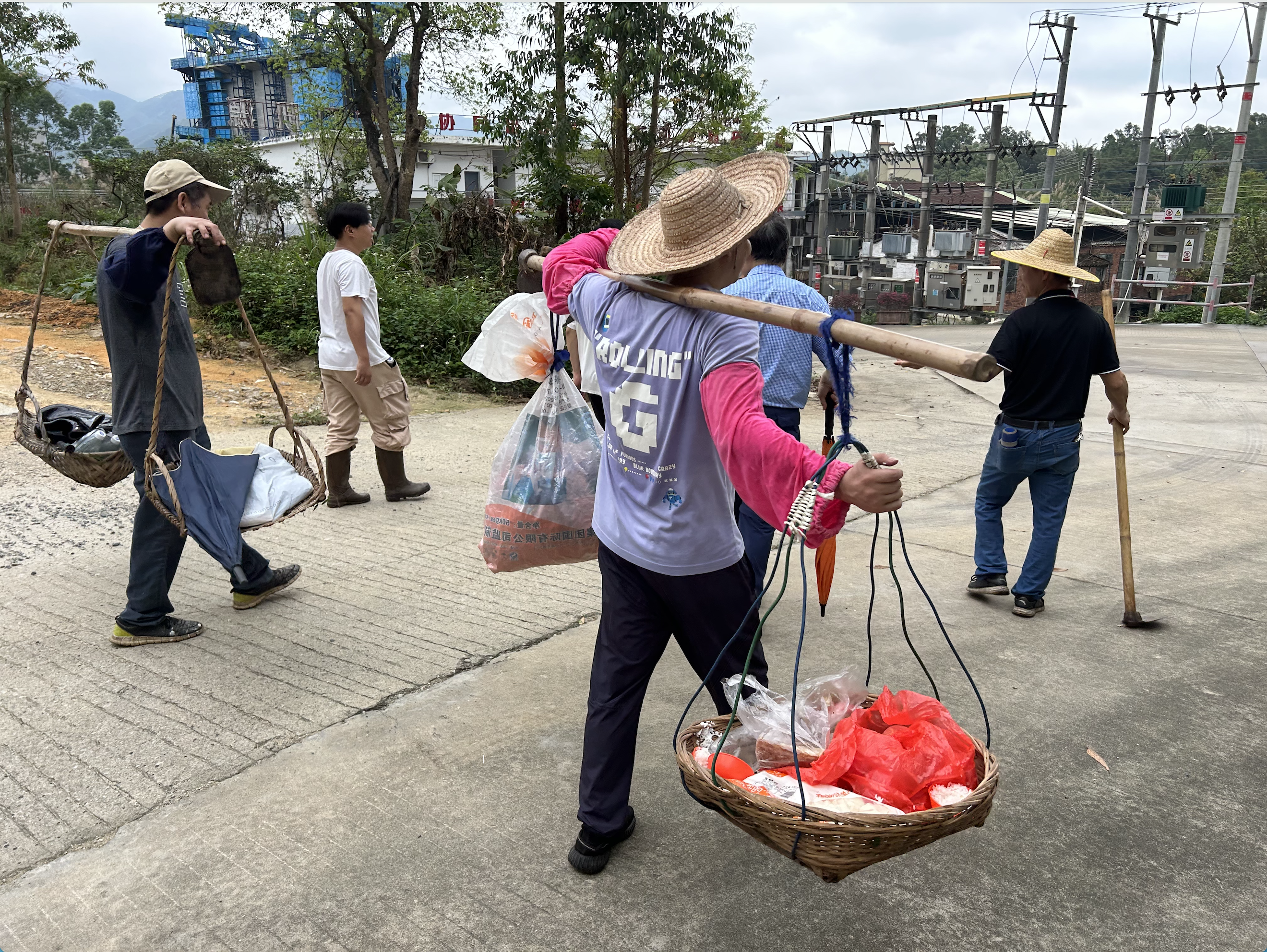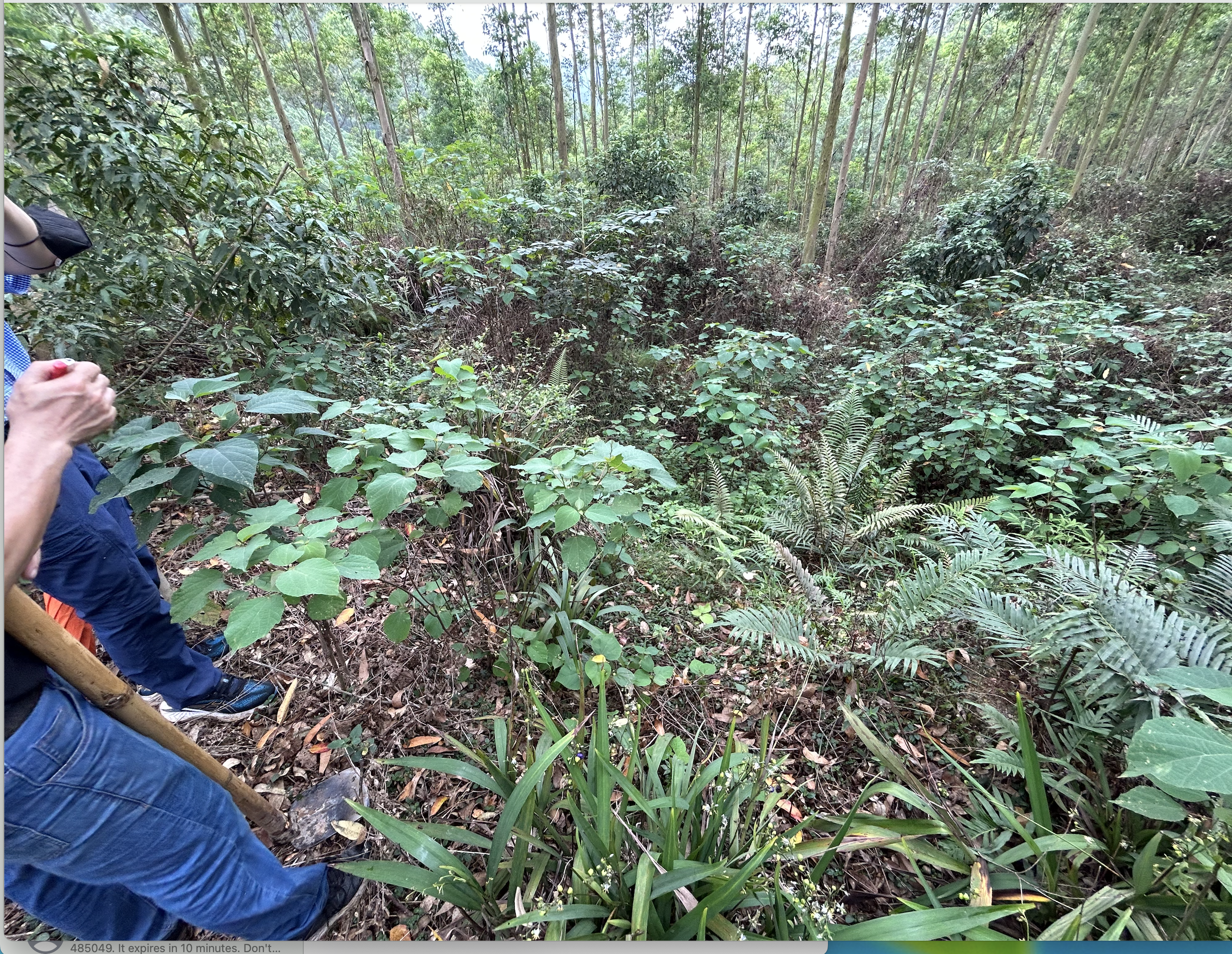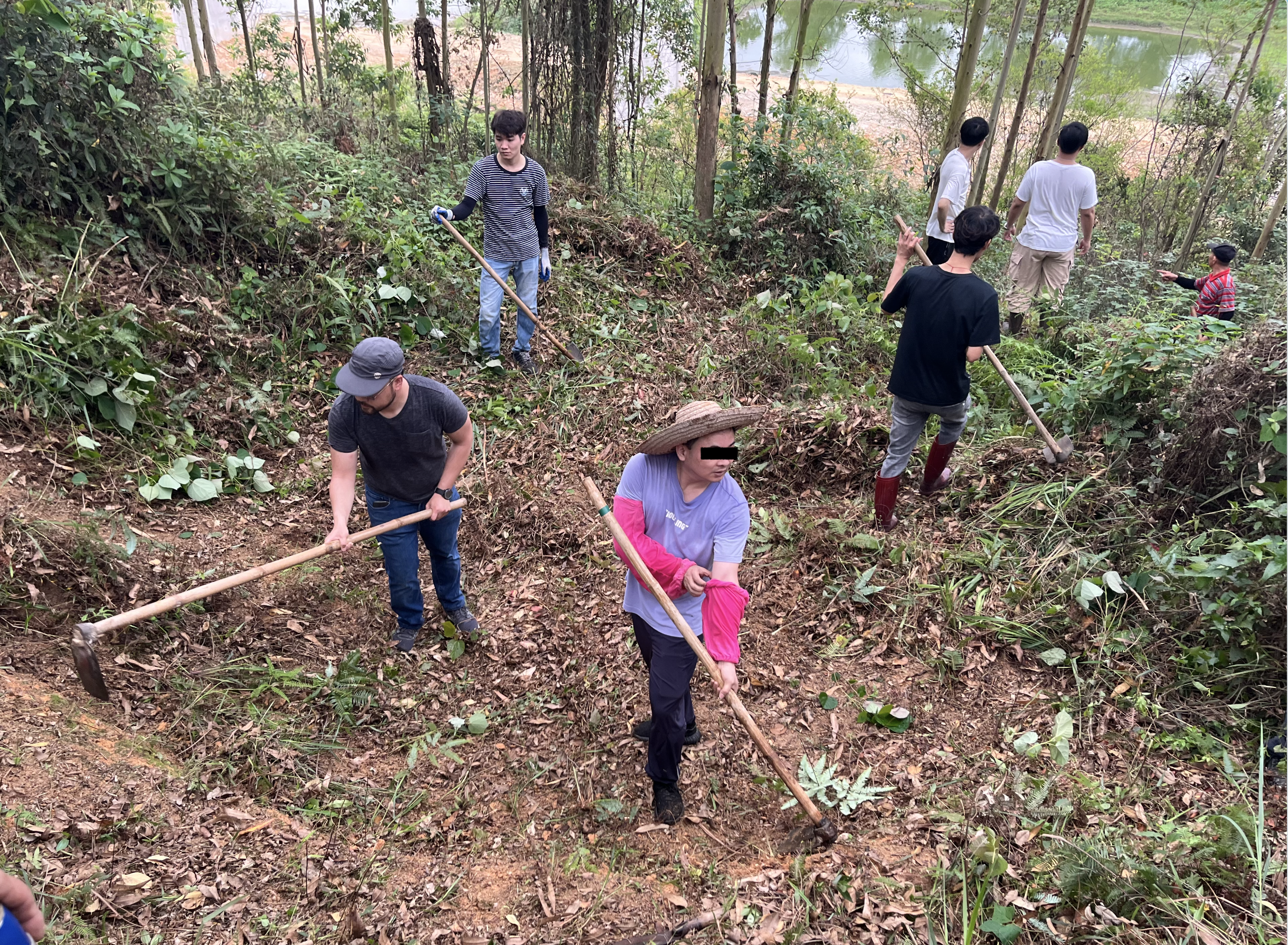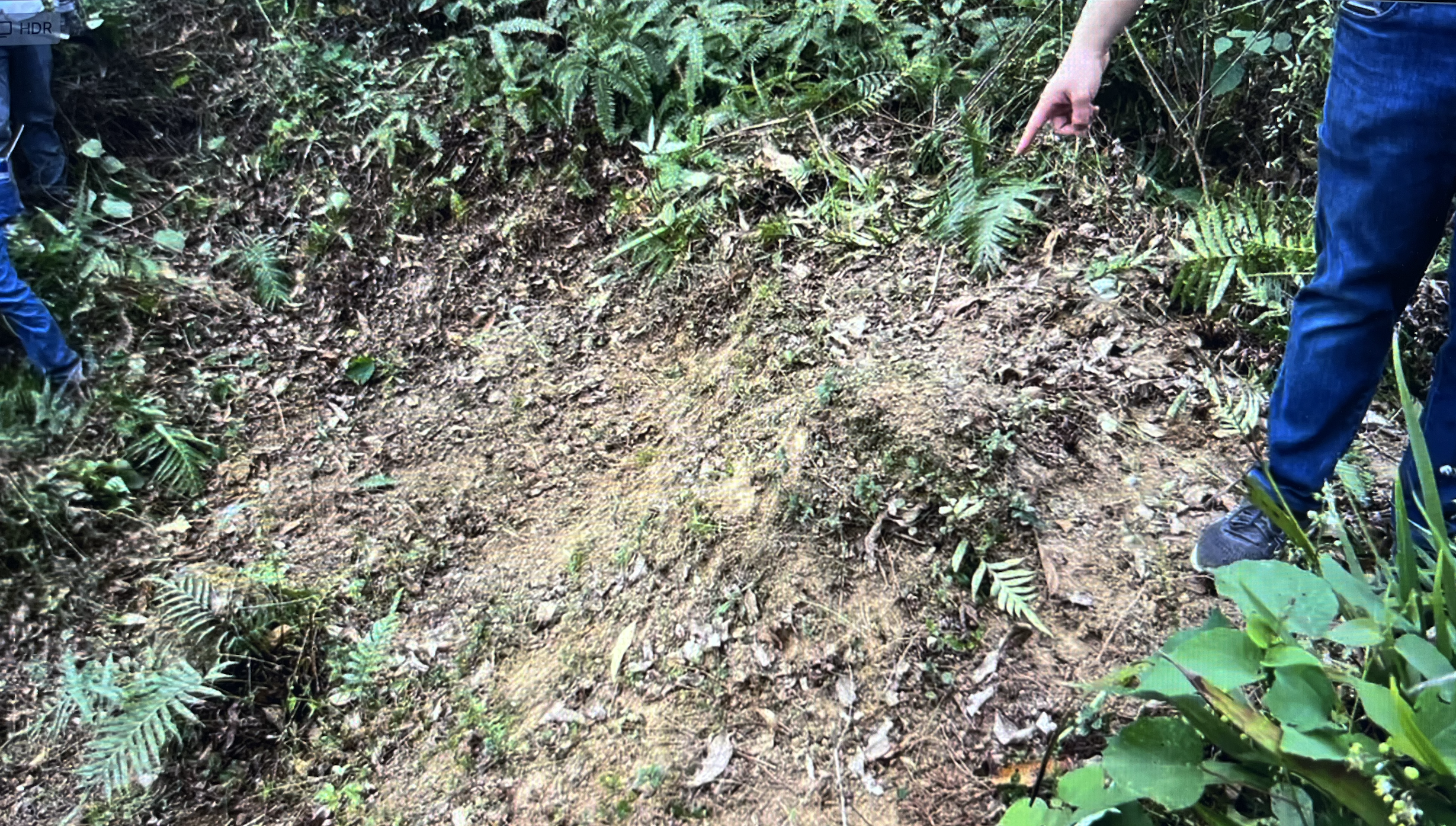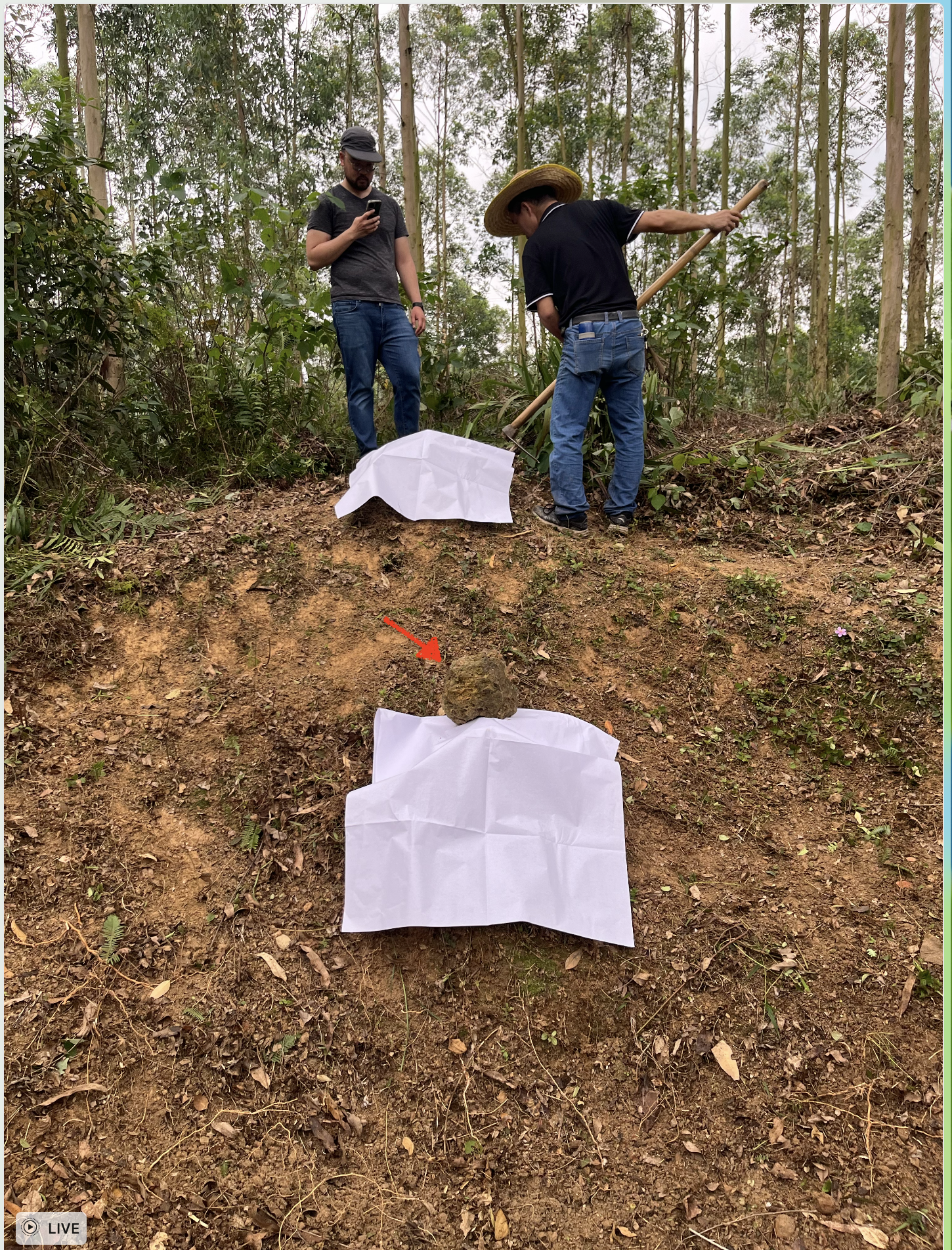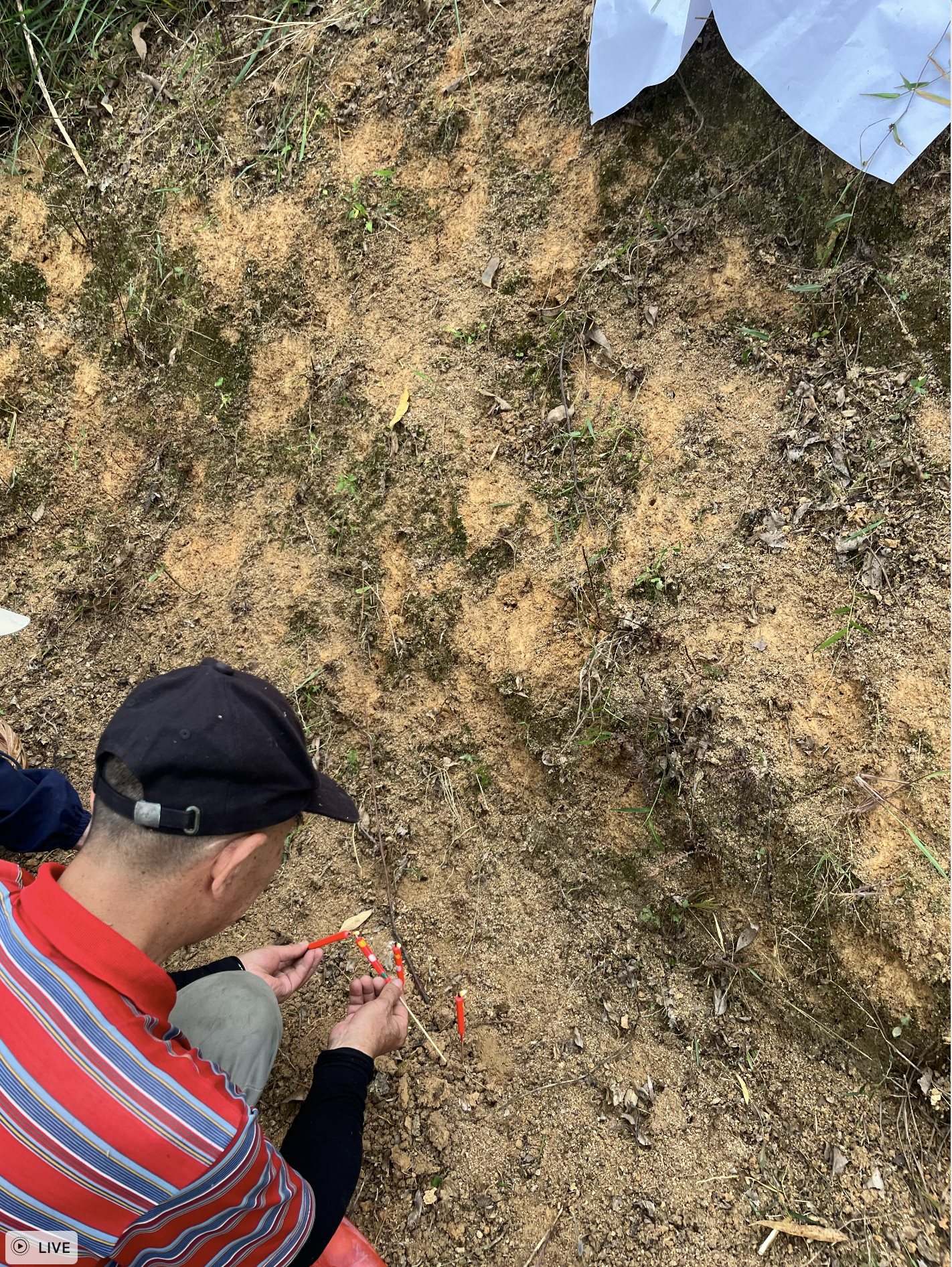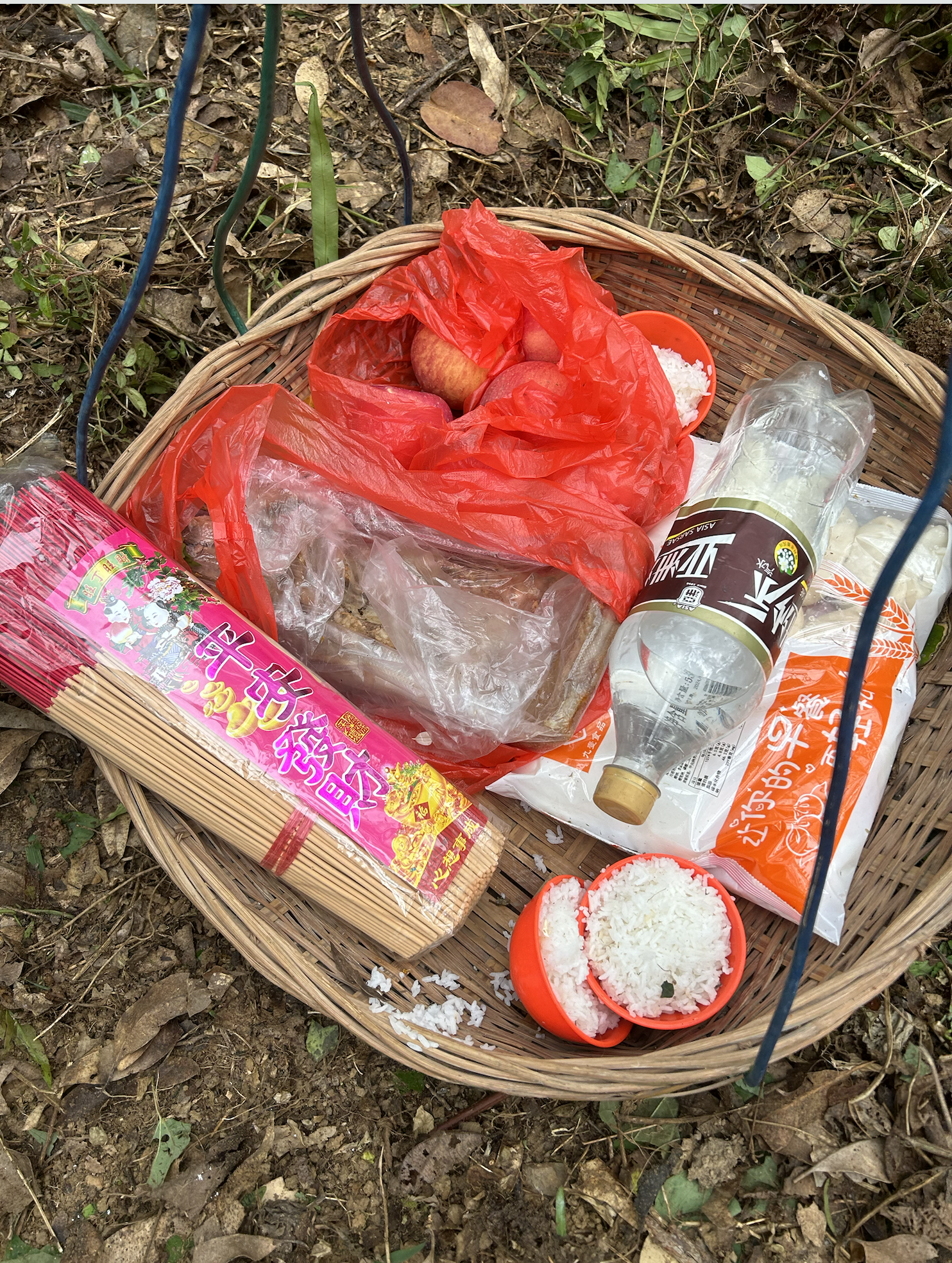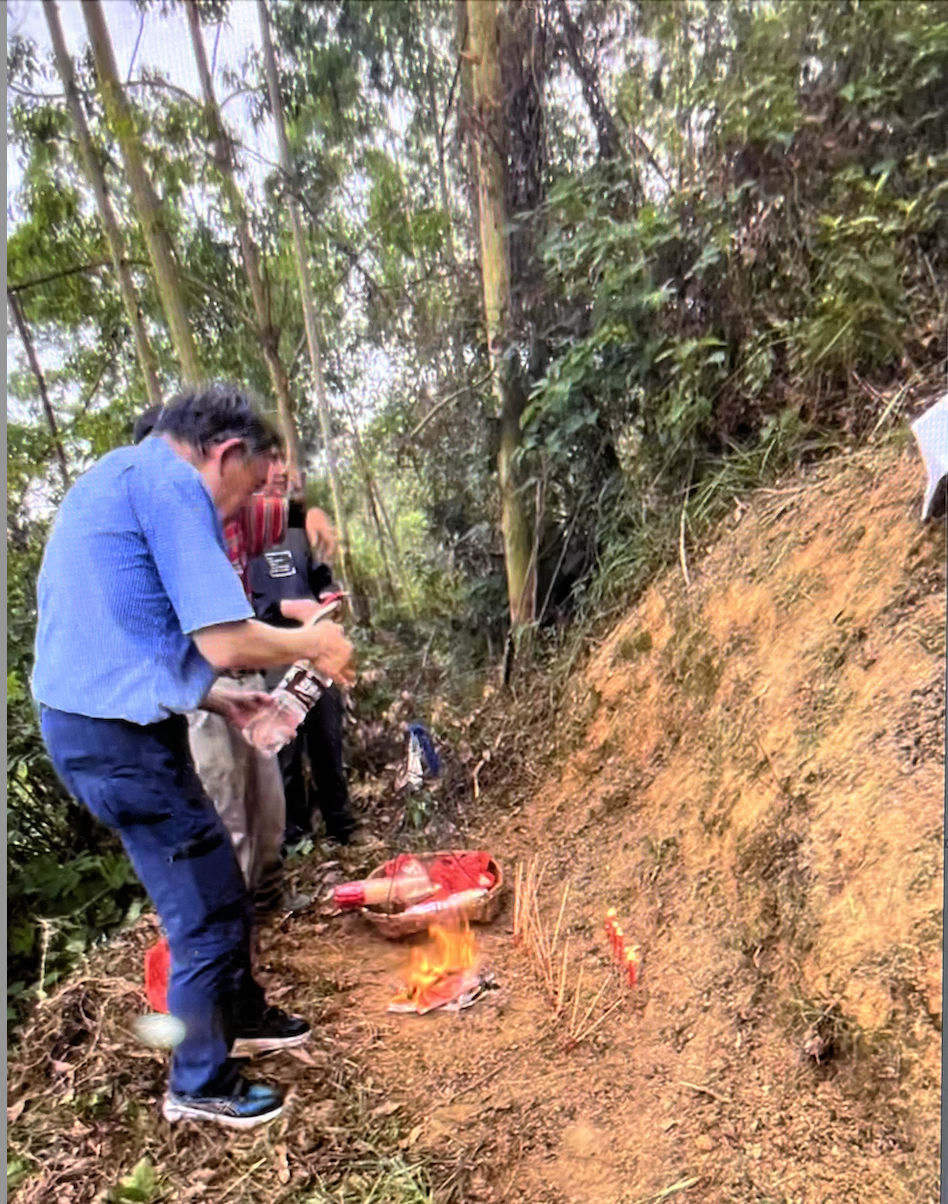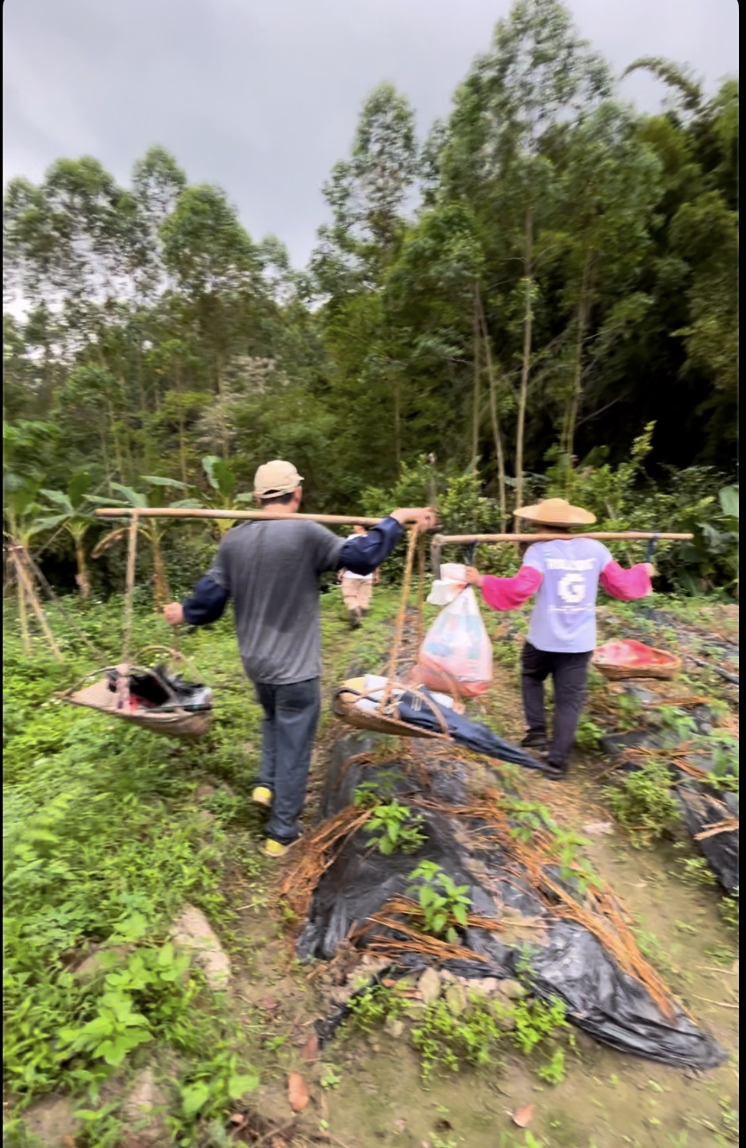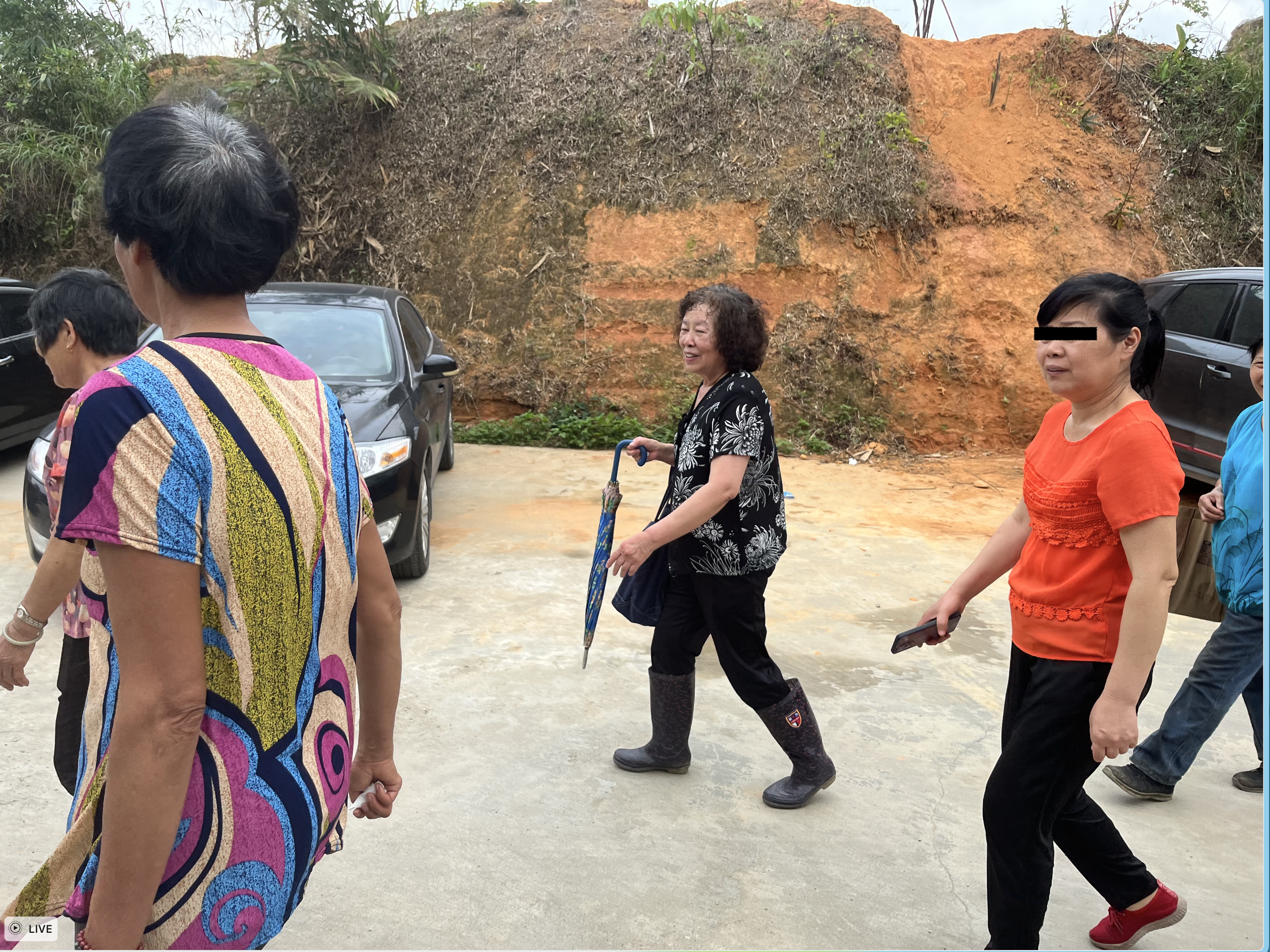|
↑
Photo 1: Off deep into the hills to honor the Ancestors! These are my cousins and nephews sharing an ancestor from the 1700's, my cousins and I being his eighth generation descendants and my nephews being his ninth.
|
|
↑图一:到深山祭祖去!这是我的堂弟和堂侄们。我们有一个曾经生活在1700年代的共同祖先,我和我的堂弟是这位祖先的第八代后人,我的堂侄们就是第九代后人了。
|
|
First, one big difference with North America, as I found out, was that this was a communal, group affair. Unlike here in North America, where Qing Ming was a single family by family commemoration of their deceased grandparents or great grandparents, at my ancestral village it was a clan by clan collective commemoration of common ancestors a number of generations back.
|
|
一开始,我便发现了一个广东乡村跟北美清明很大的不同:这是一场集体的活动。北美的清明是一个一个单独家庭对已故祖父或曾祖父的纪念,而我祖籍乡村的清明是一“房”一“房”族人对好几代前的祖先们的集体纪念。
|
|
So what is a “clan”? To answer this we have to start with the First Ancestor. In my village and the four neighboring villages, all the people had Feng for surname, and, except for the women who married in from other villages, they were all descended from the same First Ancestor. He was a pioneer who migrated from the north 23 generations ago counting back from me, which would be over 600 years ago, in the mid- or late 1300s. At the beginning, the first few generations after the First Ancestor were all one clan, and together in one clan on Qing Ming they honored their ancestors from those first few generations. After a number of generations of population growth, however, there were too many ancestors to all honor in one day, so the people took the First Ancestor’s sons and divided themselves by who was descended from which son into clans. Each clan took one of the sons as the Clan Ancestor, and each clan separately honored the ancestors belonging to that clan. Of course, if the First Ancestor had only one son, or only one son had living male descendants at the time of clan division, then the grandsons of the ancestor would be the dividing generation. If there was only one grandson or only one grandson with living male descendants, the great-grandsons would be the dividing generation. In short, the earliest generation of ancestors that had more than one son with living male descendants was selected as the dividing generation. Then again, after several more generations, when the ancestors in a clan would become too numerous, the clan members would divide the clan again, again using the earliest generation after the Clan Ancestor that had more than one son with living male descendants as the new dividing generation. Thus, throughout centuries of division, every person belonged to a clan. I belonged to the Wen-Kai clan, and our Clan Ancestor was Feng Wen-Kai. Ancestor Wen-Kai lived eight generations ago counting from me and nine generations ago counting from my children, which meant that he lived in the mid- or late 1700s. His brothers also had clans: the Wen-Can, Wen-Zhuo clan, and Wen-Huan clans. Also, there were other clans in the villages. On Qing Ming day, these clans were the large groups in which people collectively honored their ancestors.
|
|
什么是“房”呢?要从村的“始祖”说起。我村及相邻的四个村子里,全部人都是姓冯的,除了从外村嫁进来的妇女们,都可以追溯到同一位始祖。他是一位从我数起二十三代前即六百多年前,大约1300年代后期或1400年代早期时,从北部迁徙下来的开垦者。开始时,始祖之下的头几代就是一个房,清明日都一起拜祭他们那几代的共同祖先。但之后,经过了若干代的繁殖后,祖先人数变为太多,一天拜祭不了,他们就以始祖生下的几兄弟为分界,分为几个房,每个房以其中一个兄弟为“房祖”,各房各自祭拜属于该房的祖先。当然,如果始祖只有一个儿子,或分房时只有一个儿子有尚存男性后代,就以始祖的孙子一代为分界。如果孙子也只有一个或只有一个孙子有尚存男性后代的话,就以曾孙一代为分界。总之,选择最早不但有几兄弟,而且几兄弟都有尚存男性后代的一代祖先为分界。再过若干代后,当有一个房的祖先人数再次变为太多时,房成员们又会把房祖之后最早有尚存男性后代的几兄弟的一代祖先为新的分界,再次分为几个房。这样一路分下来,每个人都属于某个房。我所属的是文开房,房祖是冯文开。文开祖从我本人往前数是八代前,从我子女数是九代前,这就意味文开祖生活于1700年代中期或后期。他的兄弟也有房:文灿房、文灼房、和文焕房。乡里还有其他的房。清明节那天,这些房就是人们集体祭祖的大群体。
|
|
Also, in North America, where those who went to do Qing Ming activities were not descendants of the same ancestor, people just went at whichever hour on whichever day close to Qing Ming that suited them, but here in China, where those who went all belonged to the same clan ancestor, people all went in the morning on Qing Ming Day, to collectively honor their ancestors with members of their own clan.
|
|
此外,在北美,因为祭祖的人们并不是同一个祖先的后代,所以人们祭祖时,怎么方便自己一家人便怎么在清明前后几天中选择方便的一天,再在那天中選擇某个方便的钟点來祭祖。但是,在中国,祭祖的人们都是同一个房祖先的后代,所以人人都是在清明该日的晨早里一起开始,跟同房族人集体祭祖的。
|
|
Such a communal affair would not be possible, of course, if Qing Ming were not a three day holiday in China. This way, the people who lived away from their home villages in the towns and cities had time to come back to the village, typically the day before Qing Ming. Most village people nowadays either drove a car or rode a motorcycle, so the highways would often clog up with traffic jams -- the Chinese countryside would become a busy scene. Families, cousins, uncles, relatives, and neighbors, all gathered, visited, and coordinated and discussed tomorrow's matters. Besides preparing meals, the women also busied themselves preparing the next day's food offerings, the incense, the candles, the paper money and paper silver ingots, and so forth. The men sharpened their sickles, examined their hoes, and got the ceremonial wine and firecrackers ready. The village buzzed with activity.
|
|
当然,如果中国清明不是三天假期的话,这样的大群集体活动就不可能实现。有了三天假期,住在村外城镇的人们便有时间回到村里,通常,人们在清明的前一天回去。现在,大多数村民都驾驶自己的汽车或摩托车,所以公路会堵车,中国乡村的周边热闹起来了。家人、堂兄弟、叔婶、亲戚和邻居们都聚集在一起,互相探访,协调讨论清明当日的事宜。妇女们除了做饭外,还忙着准备祭品食物、香火、蜡烛、纸元宝、纸钞票等。男人们则在磨镰刀、检查锄头、准备祭祀用的酒和鞭炮。村子里一片繁忙。
|
|
Another big difference with Qing Ming in North America was that the graves were not in any set graveyard, but were spread out all over the hills, on inarable slopes considered before to be wasteland belonging to no one. For our clan's earlier ancestors their graves were farther from the village and more scattered up in the steeper hills, among the often wild, tall woods. In contrast, for the later ancestors, their graves were mostly concentrated in a lower undulating hillside about a mile outside the village, a naturally evolved expansive graveyard of sorts, if you will. From the feng shui stories told by my grandfather during my childhood, it seemed that the families back then who buried the older ancestors would more freely roam with the geomancers, the diviners and judges of feng shui, farther among the hills and climb higher to follow the ridges' "dragon veins", to more individualistically find the best feng shui "juncture points" (穴位) for the graves. They believed that such superior gravesite feng shui would bring better fortune and more blessings to the descendants.
|
|
另一个跟北美清明很大的不同是这些坟墓并不设在某个坟场里,而是分散在山丘上,分散在以前被认为是荒地的无法耕种的斜坡上。我房族人比较早期祖先们的墓地,离我的村庄比较远,更多分散在比较陡峭的山丘上,很多时候是在荒野的高大树林中。相比之下,比较近期祖先们的墓地,大多集中在距离村庄约一英里的虽然有起伏但是比较低的山坡上,可说是一个自然演变出来的一种广阔坟场吧。回顾我小时候听祖父讲的风水故事,似乎那些当年埋葬早期祖先的家人们更愿意跟风水先生们跑更远爬更高,来顺着山脊的“龙脉”,更加个别化地寻找最好的穴位,他们相信,这种更优越的墓地风水会为后代带来更好的福祉。
|
|
One more difference with North America is that the older graves among the wilds did not have any grave structures built over them, nor did most even have tombstones. In fact, from what I had seen, an older grave among the hills was usually just a mound of dirt, often discernable only after the lush past year's vegetation was cleared off the grave by the group's hoes and sickles, and pointed out as the grave by the group. This had to be an art, a collective art, another good reason for Qing Ming in China to be a collective affair.
|
|
跟北美另一个不同之处是,早期祖先的野外古坟上面并没有任何坟墓建设,很多连墓碑或标记都没有。山里我所见的多数古坟只是一堆土,通常是大伙用锄头和镰刀清除了覆盖着它的茂密植物后,被指出才能被辨认为坟墓的。这一定是一种特别技能,一种集体的特别技能,是中国清明必须集体祭祖的又一个好理由。
|
|
To make offerings to the older ancestors deep in the hills, therefore, the younger and stronger men from the clan would come together every Qing Ming in a "Mountain Graves Team". They had to trek far up into the hills, and after arriving at each grave, clear the plant growth, carry out the ceremony, and move onto the next grave. For our Wen-Kai clan, there were sixteen of these earlier ancestors on thirteen slopes spread among several hills. After finishing all the graves, team members also had to come back to the lower hill close to the village that contained the more recent graves, and join their waiting family groups to make offerings to their graves there. Thus, on the day of Qing Ming, our clan divided up into two groups: a small one of strong males who set out walking early in the morning, and a much bigger one of anyone not inclined to do a half day of arduous climbing and trekking with a load and clearing of subtropical undergrowth, plus women, children, and older folk, who set out by car or motorcycle for the hill close to the village late in the morning. Though there was no trekking or much climbing, from the road's arrival point at the foot of the hill they too must also cut down a year's growth of plant cover, make a path to their graves, and then clear an area around the graves to serve as the stage for making the offerings. On a per person basis, however, there was far less plant cover to clear than for those who went deep into the hills. Those families with men in the "Mountain Graves Team" would wait for the men to come back from the deep hills and then together make offerings.
|
|
所以,为了拜祭深山里的早期祖先们,我房族人中比较年轻和比较壮健的男子便每清明构成一个“拜山队”。他们要远走山中,到十三个斜坡上的十六个属于文开房比较早期的祖坟前,清除植被和进行祭拜。都祭拜完之后,他们还须回来那座靠近村庄、有着比较近期的坟墓的较低的山丘,加入等待着他们的家族人群,一起祭拜那里的祖坟。那么,清明日族人们便分为两批:一小批壮健的男士,大清早便徒步出发去远,和一大批其他任何不愿意做半天攀爬、跋涉和斩锄亚热带野草灌木丛等重活的人们,妇女、儿童、和老人,他们上午晚些时候才乘着汽车或电单车出发到靠近的那座山丘。虽然无需远走或攀爬深山,但是他们也仍然要从山脚的车路到达点起,斩除一年以来的植被,开路到坟地,然后在坟地周边清除出一片空地来作为祭拜场所。当然,按人均计算,需要清除的植被比进入深山的人们要少很多。那些有“拜山队”成员的家庭,便会等待他们从深山里回来才一起祭拜。
|
|
Feeling strong and adventurous, I decided to join the Mountain Graves Team. That made eleven of us this year, among whom eight belonged to our Wen-Kai clan's ninth generation, and three belonged to the eighth generation. Therefore, we had distant cousins and we had distant uncles and nephews. We shouldered hoes, and two Team members each slung a load on each end of his shouldered hoe. One team member had on one end of his hoe a large shallow straw basket about two feet in diameter that contained the offerings of barbecued pork, three plastic bowls of rice, a package of white buns, a bag of apples, a large bottle of wine, and a large bundle of incense sticks, all covered and wrapped with an auspicious red plastic sheet. On the other end of his hoe he had a big plastic bag containing the sacrifice paper money, foled up three feet or so square sheets of large white paper for decorating the graves for the ceremonies, firecrackers, and bottles of drinking water for the trekkers. The other load-carrying team member carried two large flat bottom scallop-shaped straw baskets slung from his hoe, and in them were sickles, fording boots, umbrellas, raincoats and gear for the team. When I tried carrying just one of the straw baskets afterwards, I found it surprisingly heavy, and even when carried by itself, so was the hoe -- my clansmen were strong indeed! Of course, the loads were rotated among the men and carried in shifts. By the way, the three "aged" members of the Team from the older eighth generation, I among them, were not given any loads to carry.
|
|
我喜爱挑战,又觉得自己壮健,便加入了拜山队。我们今年是十一个人,其中八个属于我们文开房的第九代人,三个属于第八代人。所以,有疏堂兄弟,也有疏堂叔侄。我们肩膀背着锄头,其中两位队友的锄头两端都挑着负荷。一位队友的锄头,一端挑着一个大约两尺直径的大浅草篮,篮装着烧猪肉、三胶碗子米饭、一袋白包子、一袋苹果、一大瓶酒、和一大捆香枝,全部被一块吉祥的红胶纸包着。他锄头的另一端则挑着一个大胶袋,装着祭祀纸钱、用来祭祀时装饰坟墓的折叠起来的三尺多宽大方块白纸、鞭炮、及多瓶供大伙喝的清水。另一位队友的锄头则挑着两个大平底扇貝形草籃,里面装着镰刀、水靴、雨伞、雨衣、及队友们的装备。事后我尝试了用锄头只挑起一篮,发觉篮子出乎意料地沉重,而锄头当单独挑起时也一样地沈重 -- 哎,我的族人真强壮啊!当然,这些担子是轮流各人挑一程的。顺便提一句,包括我在内的属于年长一点的第八代的三个“上了年纪”的队友,不被给予担子来挑。
|
|
Carrying our all, we set off walking from the front of the village, along the divided highway. Soon we crossed over and went into the fields. Then we found our own way through farm fields, wet grass, shallow marshlands, and gullies. We crossed streams balancing on single logs, with the two shouldering the loads performing what I thought were feats of both strength and balance. The first hill we came to was steep, with several nearly vertical slopes; we had to rely on stepping on the roots of plants and grabbing onto tree branches and grass stumps to crawl our way up. Those who climbed up first took the baskets and the big plastic bag that were handed up one by one, then stretched out their hands to help pull up those below. With lots of calling out and encouragement to each other, the esprit de corps and camaraderie were palpable.
|
|
携带着所有这些东西,我们队从村头步行出发,沿着高速公路走。很快我们便穿过公路,走进田野里。我们开辟自己的路,走过田地、草地、浅泽地、和溪沟。我们踩着独木过溪流,挑着担子的那两位展现着卓越的体力和敏捷。到达的第一座山丘,有几壁近乎垂直的斜坡,要靠踏着植物根子和抓着草堆树枝等才能爬到上去。最先上去的,接过被递上的篮子和大胶袋后,又伸手拉下面的人,帮助他们上去。互相呼叫鼓励,团体精神和同志情谊显而易见。
|
|
Once we got onto a hill that had one or more graves, it was all in the woods. So even though we often followed a rough foot trail, the undergrowth of bushes, tall grass and plentiful plants made one spot indistinguishable from another as we moved along. Somehow though, the group knew when to stop and call out, "Here is Ancestor So and So!" Typically it was down a slope off the trail, with the slope facing some scenery. Then the group would climb down the slope, often having to hack a path through the shrub, grass and ferns as they did so. Then they would unleash hoes and sickles on the plant growth. In my clansmen's skillful hands, both hoes and sickles were remarkably effective on the grass, ferns and soft stemmed vegetation, though they be quite thick and tall. In particular, sickles worked well on vegetation with hard trunks, and even over ten foot tall small trees with trunks the diameter of a small cup were being felled with single well-aimed blows from the sickle. Amazingly, in no time at all, what had been a fairly dense jungle only minutes ago became a good size clearing some 15, 20 feet in diameter of bare brown earth.
|
|
一旦走进了有墓地的山里,便全都是树林了。虽然我们很多时沿着崎岖粗陋的小径走,但是灌木丛、高草丛和浓密生长的植物使得各个地方都难以区分。不过,队伍总是知道什么时候要停下来喊,“这里便是某某祖!”通常,这都是在小径侧面的下斜坡,斜坡面对着某些景色。族人们便爬下斜坡,很多时要在灌木和蕨草蓬中砍一条路才能下去。然后,对付茂盛的植物,锄头和镰刀就用上了。在族人们熟练技巧的操作下,锄头和镰刀铲除草、蕨和其他软杆茎植物都很有效,尽管它们长得又高又密。镰刀则对硬杆茎的植物尤其有效,一个树干直径有小杯子那么大,超十英尺高的小树,只需镰刀精准的一刀就会整棵倒下来。相当茂密的丛林,若干分钟后便已经被变为一片相当大的、约15至20英尺直径的棕色泥土地和斜坡,快得令人惊奇。
|
|
↑
Photo 9: Crossing a field, off to the next hill!
|
|
↑图九:跨越田野,往下一座山走!
|
|
It was noon by the time we got back to the main hill near the village with our clan's later ancestors' graves. Here most graves had structures built around, some even quite large, or they at least have upright tombstones. The large hillside was dotted with many groups of people, each group gathered around its grave. These were smaller groups of our clan that had divided up counting back only four or five generations, each group commemorating the graves of ancestors shared by the group members. My own smaller group shared my great grandfather as the common ancestor,and so they were my aunts, uncles and cousins with some distance, and their wives and children. Most groups had already cut paths through the vegetation from the road to the graves, and most graves already had the areas in front cleared of vegetation. Also, except for the few groups that had members in the Mountain Graves Team and were still waiting for us to join, most groups were already beginning their offerings activities. Here there were the elderly, the middle aged, young men and women, teens, children, and babies. Many had returned only this morning from outside the village, including those who lived and worked in the towns and cities, the high school students who lived in residence at the town's high schools, college students, and so forth. Like other people on the hill, after commemorating our group's deceased, we started busying ourselves around the grave asking after each other, bringing each other up to date, and sharing news about people we mutually know. At this time, those from an older generation could mingle with young people and children in a more relaxed and informal manner. The smoke from the incense, the fiery flames from the burning offering piles of paper money, paper home appliances and paper cars, the laughter of people conversing, the running children's cries of joy, and the many explosions of strings of firecrackers, all came together to weave a rich atmosphere of a festive holiday celebration.
|
|
当我们回到靠近村子、埋葬后期祖先和现代前人的主山丘时,已经是中午了。这里的坟墓,绝大多数都有了坟墓结构,有的甚至规模很大,或者至少有直立的墓碑。大山坡上可以看到各个墓前都围着一群人,这些都是我房族人,大家分开成为只是四至五代的群体,前往祭祀各自的前人。我所属的四至五代群体,共以我的曾祖父为祖,所以这个群体里的人都是我的疏堂叔婶、疏堂兄弟,及他们的配偶和子女。大多数群体都已经从通往这山坡的马路用镰刀和锄头开辟了路径到各自群体的墓前,亦在各墓前清除了一片用以祭祀的土地。而且,除了有成员参加了我们这个拜山队的几个群体还在等待我们回来之外,多数群体都已经开始祭祀了。这里有老人、中年人、年青人、少年、儿童、和婴儿等。很多人是从村外今晨才赶回来的,包括在城镇工作和居住的人们、镇里学校住宿的中学生、大专院校生、等等。和山坡上的其他人一样,我们拜祭了我们群体的前人后,便忙着围在墓前互相问候交谈,互通近况,分享我们共同认识的人的消息。这时,年长的一辈可以跟年轻人和儿童比较无拘束地交流。山坡上的香枝烟气、祭祀纸元宝堆和纸家具纸车堆等燃烧的熊熊火焰、人们交谈的笑声、奔跑着的孩子们的欢叫声,以及不断传来的鞭炮爆炸声,在这里烘托出一片浓厚的节日庆祝气氛。
|
|
After everyone in our Wen-Kai clan had gotten done with the ceremonies and the socializing, we all went to the big restaurant in front of the village and had a late but sumptuous lunch. Here several other clans from the village had also gathered to have lunch after the ceremonies, and again it was a festive event, with feasting and socializing among the tables and between the clans.
|
|
我们文开祖这房族人的拜祭仪式和相互之间的交流结束后,我们便都回村子去,聚集于村前的一家大餐馆,吃一顿晚了些但很丰富、很热闹的午饭。村中有其他几房族人今天也在这里祭祖后聚集吃午饭,几房族人的成员都于餐桌之间互访交谈,节日气氛十分浓厚。
|
|
Even though it is true that, on this village Qing Ming Day, at the graves there was solemn dignity and respectful honoring, and at the more recent graves there was some nostalgia and longing especially for those recently deceased, the main current, nonetheless, was celebration. It was celebration that we had together honored our ancestors, celebration of how fine their descendants were, celebration of our blessings and happiness. Firecrackers were the highest Chinese symbols for celebration, and setting them off here was the most solid proof of celebration. Please note, in the tradition here, during the Qing Ming commemorations at the graves, there was no grieving, no moments of silence. In fact, even though I grew up in North America far away from here, at all the Qing Ming grave commemorations in North America since a young age, there had never been grieving or moments of silence. It had always been a respectful but lively atmosphere of a family social gathering event where honoring of our predecessors was done.
|
|
虽然这个乡村的清明日的确充满了庄严和尊敬,且在较近年代的墓前亦有怀旧和怀念,特别是对那些最近去世的亲人的追思与怀念,但占主流的还是庆祝,庆祝我们共同尊敬了祖先,庆祝祖先们的后人的优秀,庆祝我们的福祉。在这里放鞭炮是最可靠的庆祝证据,因为它们是庆祝的最高象征。请注意,这里的传统中,清明祭祀祖先时,是没有悲哀、没有默哀的。其实,尽管我在远离这里的北美洲长大,自小在北美参与的所有清明祭祖活动,同样都是没有悲哀、没有默哀的,都是一种向前人致敬的庄严但热闹的家庭聚会氛围。
|
|
↑
Photo 10: To the restaurant!
|
|
↑图十:到餐馆去!
|
|
My Conclusions
|
|
我的结论
|
|
After experiencing this day, I can clearly see why since little, I have always heard that taking part in Qing Ming's ancestor honoring activities brings blessings and good fortune. It is not superstition; it is based on fact: the clan members bond, and it is this bonding that brings the blessings and good fortune.
|
|
经历了这一天的活动后,我清楚地明白了为什么从小我就听说参加清明祭祖活动会带来好运和福祉。这不是迷信,这是有事实根据的:房族的成员们互相“感情粘结”起来了,即英语的 "bonding"。好运和福祉,就是这个“感情粘结”所带来的。
|
|
Being together in a group and honoring common ancestors through common rituals vividly impress the fact that group members share common roots and common memories upon the members' consciousness. This vigorously activates a highly positive emotional state towards each other, and it is during this time that bonding forms. Moreover, while still immersed in this shared positive emotional state, socializing after the rituals at the grave site and feasting together afterwards, provide yet more crucial moments when bonding forms. With such bonding come mutual good will and strong warm feelings for one another. And this bonding is re-formed and reinforced every year at Qing Ming.
|
|
这一天,群成员共聚在一起,以共同的仪式来尊敬共同的祖先,把群成员们享有共同根子和共同记忆这个事实生动地展现在成员们的意识里。这就极大地激发了彼此之间积极正面的情绪状态,“感情粘结”便在这个时候形成了。此外,当人们仍然沉浸在这种共同的积极情感状态中时,礼后坟前的问候交流和之后的聚餐宴会,为“感情粘结”的建立提供了更多关键的时刻。这种“感情粘结”所带来的是彼此之间的善意和深厚的温暖感情。而这种“感情粘结”是每年清明时都再形成、再加固的。
|
|
As for those strong and determined men who journey into the hills to arduously clear the growth cover and honor their common ancestors together, they bond even more -- indeed the more arduous the day the deeper the bonding. “We honor the mountain graves together, how can we not be brothers?!” Before, when I heard people say that, I could not follow their logic; it seemed a bit weird. Now I can. Yes, honoring the mountain graves together will make you brothers.
|
|
至于那些走进陡峭深山里跋涉攀爬、清除植被、共同艰苦地拜祭远祖的强壮坚毅男士们,他们的“感情粘结”则更为坚固 -- 其实,越艰苦便越坚固。“我们是一起拜山的,怎能不是兄弟!”以前,当我听到别人这样说时,我想不通他们的逻辑,好像是怪怪的。现在想得通了。对,一起拜山,就会成为兄弟。
|
|
Bonding leads to strong mutual trust, mutual help and mutual cooperation. What comes after "how can we not be brothers" is "of course I trust him!", "of course I will help him!", or "of course I will cooperate with him!" Therefore, the people who take part in Qing Ming activities enjoy the precious resources of strong trust, help and cooperation from an entire group of people. Naturally, then, they are more capable of attaining prosperity, success and happiness. This, of course, is exactly the blessings and good luck brought by Qing Ming's ancestor honoring activities.
|
|
“感情粘结”带来坚强的相互信任、相互帮助和相互合作。“怎能不是兄弟”的之后便是“我当然信任他!”、“我当然会帮他!”、或:“我当然会跟他合作!”所以,参与清明的人们拥有一整个群体的坚强互信、互助和合作这些珍贵的资源。那么,自然地,他们就更有能力获取富裕、成功、和快乐了。当然,这,就是清明的尊祖活动所带来的好运和福祉。
|
|
Is this why the deeper and steeper the hill the better the grave site feng shui, and the more the blessings to the descendants? It must be the deeper bonding! Wise indeed, this Qing Ming tradition...
|
|
这就是为什么山越深越陡,墓地风水就越好,越能为后代带来更多福祉的吗?一定是更为深厚的‘感情粘结’带来了这一切!智慧啊,这个清明传统 . . . .
|
|
~ ~ ~ ~ ~ ~ ~ ~ ~ ~ ~ ~ ~ ~ ~ ~ ~ ~ ~ ~ ~ ~ ~ ~ ~ ~ ~ ~ ~ ~ ~ ~ ~
|
|
~ ~ ~ ~ ~ ~ ~ ~ ~ ~ ~ ~ ~ ~ ~ ~ ~ ~ ~ ~ ~ ~ ~ ~ ~ ~ ~
|
|
Please click to see:
Poem I wrote at the Village the Day After
|
|
请点击观看:
清明后一天我在村里写的一首诗
|
